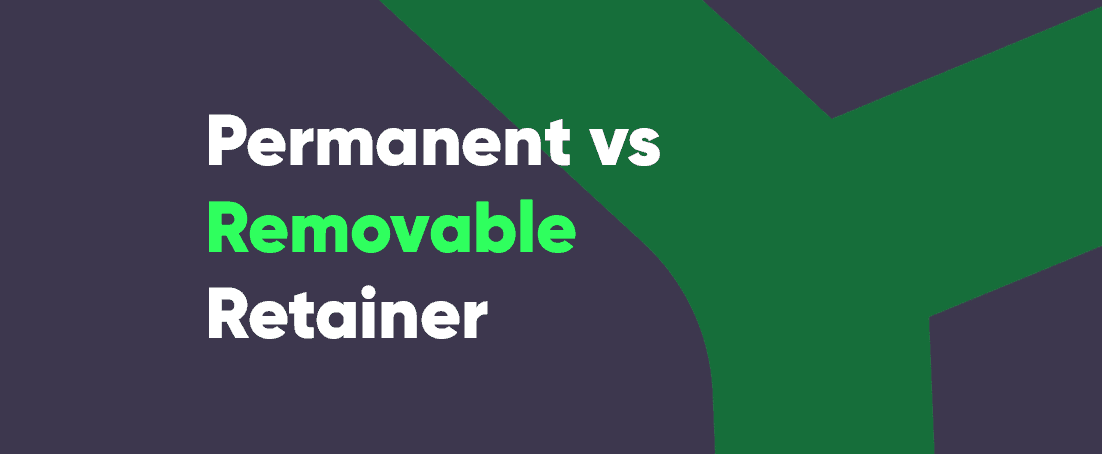Choosing between permanent and removable retainers post teeth straightening treatment is a common topic in orthodontics. When the need for retainers arises, it’s important to know the good and not-so-good things about each option for taking care of your teeth after braces. By understanding the nuances of permanent and removable retainers, you can confidently participate in your post-orthodontic care and maintain a beautiful, healthy smile for years. In this article, we’ll talk about why removable retainers are often a better choice.
Table of Contents:
Permanent Retainers
Permanent retainers, also called fixed bonded retainers, are custom-fit wires made of metal or strong fiber. They are attached to the back of the teeth using special cement. Installed right after braces are removed, these retainers stop straightened teeth from moving back.
Permanent retainers win the race when it comes to durability, with many users reporting they last up to 20 years. They are more discreet than conventional removable retainers and don’t need the wearer to remember to put them in or take them out. They can be fixed across the front or all teeth, based on individual needs.
Although they offer long-term results, cleaning and maintenance of a permanent teeth retainer requires extra effort, and their visibility can make keeping teeth clean a bit challenging. The choice between permanent and removable depends on factors like durability, aesthetics, and maintenance preferences.
Benefits of Permanent Retainers
Permanent retainers are attached to your front teeth, and do their job all the time, helping your teeth stay in place. After braces, these retainers stop your teeth from going back to how they were.
As permanent retainers are hardly noticeable, you can smile without anyone knowing your secret weapon. No need to remember to put the retainers in or worry about losing them. Just eat, and brush, and you’re good to go!
Permanent retainers might not be for everyone, but if you want a hassle-free way to keep your smile bright, they’re worth thinking about. Talk to your dentist or orthodontist to see if they’re the right fit for you.
Permanent Retainer Drawbacks and Considerations
Permanent retainers bring challenges like tricky cleaning, potential discomfort, and impact on oral hygiene. Maintaining good oral hygiene with them can be tough as they may trap plaque and food particles. Regular dental check-ups are vital to watch over the retainer’s condition and ensure proper oral health.
While permanent retainers offer lasting results and remove the need for constant wear, they demand extra cleaning effort, and their visibility can make teeth cleaning harder. Not cleaning your teeth well enough can lead to problems with gum health or even cavities. So, effective home care is crucial!
Removable Retainers
Removable retainers, crafted from clear plastic or acrylic, are custom-made tools that preserve tooth alignment post-orthodontic treatment. They encase the teeth completely, providing a flexible and convenient option for maintaining corrections. The best thing about removable retainers is that they can be taken out for activities like eating and brushing, offering adaptability in daily life.
Although their effectiveness relies on consistent wear, the flexibility of removable retainers suits individuals seeking convenience. The choice between permanent and removable retainers hinges on considerations like durability, aesthetics, and maintenance preferences.
If you are considering switching to removable retainers and wonder about “Can you get a permanent retainer removed?” our in-depth guide about fixed retainer removal would be a helpful read.
Benefits of Removable Retainers
Removable retainers, like Remi retainers, bring multiple benefits, notably ease of cleaning and enhanced oral hygiene. As custom-made orthodontic tools, they efficiently maintain teeth alignment post-orthodontic treatment. Their standout feature lies in being easily removable for cleaning, eating, and brushing, offering unmatched convenience in specific situations.
A preferred choice for those seeking flexibility, Essix and Hawley removable retainers do require consistent wear for optimal effectiveness. While they may be less durable than permanent retainers, their easy cleaning and maintenance make them a practical option.
Removable Retainer Drawbacks and Considerations
Choosing removable retainers, while convenient, comes with its own set of challenges. The key to their success is consistent wear – forgetting to wear them even occasionally can lead to tooth movement.
Additionally, if you lose or accidentally damage them, replacements will be needed, costing you more. Taking care of their hygiene is essential to avoid plaque buildup and potential harm to your teeth and gums.
Before deciding on the type of retainer, consider your lifestyle. If you have a busy schedule or travel frequently, a permanent retainer might be more suitable. With a removable retainer, discipline is crucial, and setting reminders or making wearing the retainer a part of your routine can help. Your hygiene habits are also important as neglecting proper cleaning can cause dental issues.
Comparative Analysis: Permanent vs. Removable
#1 Effectiveness in Maintaining Alignment:
When evaluating the effectiveness of maintaining orthodontic alignment, both permanent and removable retainers show promise. A comprehensive review indicates that, when patients adhere to instructions, both types effectively preserve aligned teeth in the long term.
In a 2018 study, it was suggested that a fixed retainer contributes to maintaining front teeth alignment over an extended period.
However, according to a critical review of fixed and removable orthodontic retainers, insufficient evidence makes it unclear which retention method is better for maintaining orthodontic treatment results. Thus, it’s reasonable to state that both fixed and removable retention methods can effectively stabilize the teeth arrangement.
#2 Comfort and Adaptation
Permanent retainers can be uncomfortable for some individuals, requiring extra effort for cleaning and potentially causing discomfort due to the metal component. In contrast, removable retainers are generally more comfortable, as they can be taken out for cleaning and eating. It is also important to learn how should a retainer fit to enhance comfort.
Permanent retainers may pose a challenge to speech due to the presence of a metal wire on the back of the teeth. On the other hand, removable retainers, especially Hawley retainers, might impact speech as well and may need some adjustments.
Both permanent and removable retainers may require an adjustment period. Permanent retainers, in particular, may need time for the wearer to get used to them, especially concerning speech and tongue adjustments. Removable retainers, especially the Hawley retainer, might also need an adjustment period as they can affect speech and may require tweaks for a better fit.
#3 Oral Hygiene Impact
Maintaining oral hygiene differs between permanent and removable retainers. A study concludes that bonded fixed retainers can complicate oral hygiene. The reason for this is that permanent retainers require meticulous cleaning around the wire, demanding extra effort. This metal component may trap plaque and affect dental health.
On the other hand, removable retainers offer easier cleaning as they can be taken out. This advantage aids in thorough brushing and flossing, minimizing the risk of plaque buildup. The choice between permanent and removable retainers plays a crucial role in shaping the impact on overall oral hygiene.
#4 Durability and Longevity
When considering how long do retainers last, it is important to understand that durability varies between permanent and removable types. Permanent retainers, typically made of metal, boast longevity but may be prone to wear and detachment. Factors such as the wearer’s oral habits and care significantly influence their lifespan.
Removable retainers, often crafted from durable materials, tend to last well too. Regular wear, cleaning, and proper storage contribute to their extended lifespan. The choice between permanent and removable retainers involves considering these factors, ensuring their durability aligns with the wearer’s lifestyle for sustained effectiveness.
Orthodontic Recommendations
Orthodontic professionals play a crucial role in recommending the ideal retainer tailored to individual needs. It’s not a one-size-fits-all scenario! The type of orthodontic treatment received can significantly impact the choice between permanent and removable retainers.
After minor to moderate adjustments, Hawley and Essix removable retainers may be suitable. For more extensive shifts, especially after braces for months or years, permanent retainers might be recommended. Your orthodontist evaluates the specifics of your treatment, ensuring the selected retainer aligns perfectly with your unique case.
Our guide about how much do orthodontic retainers cost will further help you discuss the most suitable option with your orthodontist to maintain your straightened teeth for a long time.
Final Thoughts
Choosing between permanent and removable retainers isn’t a simple decision. It’s about finding the perfect tool to retain that perfect smile for life. Many factors come into consideration, such as whether you have major adjustments or just minor tweaks during your orthodontic treatment. Or, do you like the simplicity of permanent retainers or the flexibility of removable ones?
Your orthodontist helps you make the most suitable decision. They’ll look at your case, understand your lifestyle, and recommend the retainer that’s just right for you. Trust their expertise, keep them informed, and together, you’ll choose a retainer that helps your smile stay perfectly aligned!
Don’t be afraid to ask questions and talk about your concerns regarding the type of retainer. Work closely with your orthodontist to find the retainer that suits you best.

